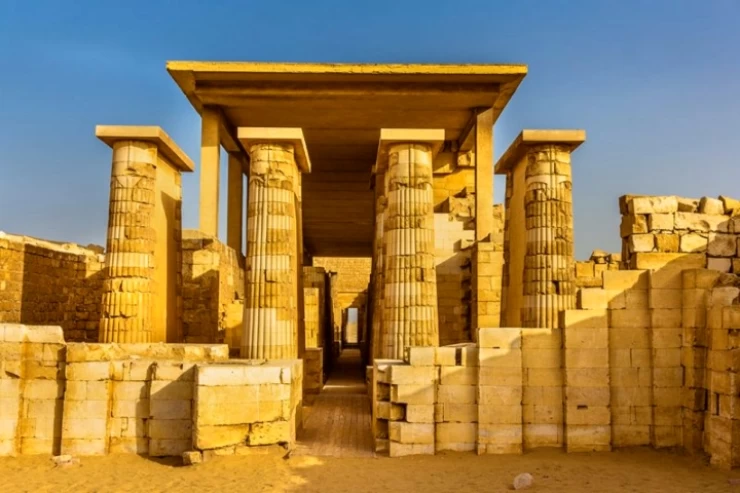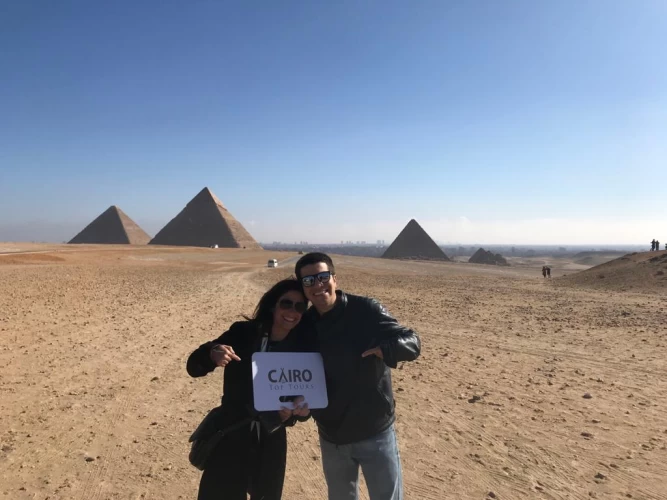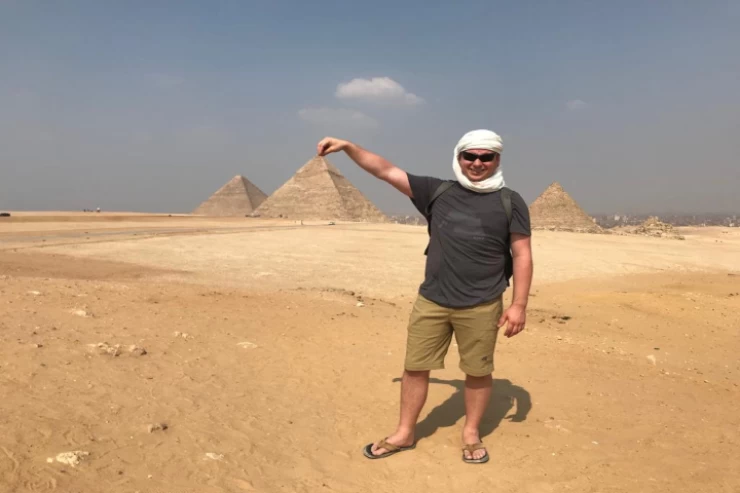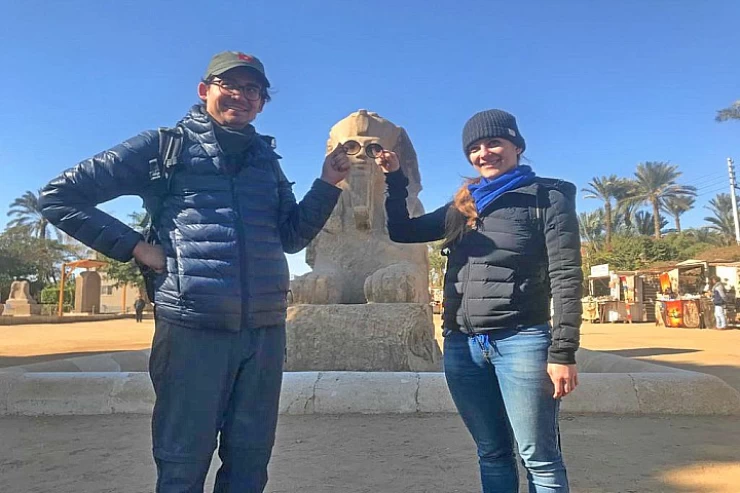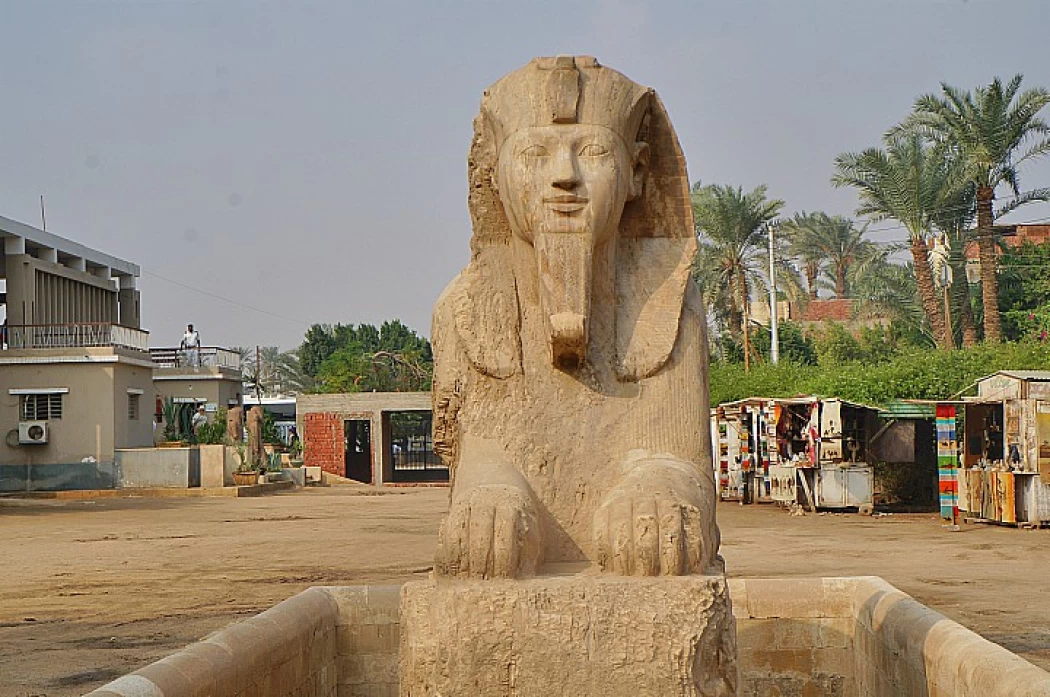
Memphis ''Capital Antiga do Egito''.
Memphis | Ancient City of Memphis
História da Cidade de Memphis
Memphis é um sítio arqueológico único e coisas para fazer no Cairo. era a antiga capital do Egito conhecida antigamente como "Inebu-hedge", o nome que não podia ser pronunciado pelos gregos, então eles a chamaram de acordo com o nome de uma das pirâmides no local da cidade, a pirâmide é chamada Mn Nefer, que significa bonito e estável. Mn-Nefer foi corrompida para ser Memphis, então os árabes não podiam dizê-lo, então chamaram a cidade de Manf, e este nome foi finalmente pronunciado pelos egípcios modernos como Mit-Rahina e que permanece como o nome atual onde tal cidade cosmopolita costumava ser.
Museu a céu aberto de Memphis
Antigamente era o primeiro nome do Baixo Egito naquela época, foi fundada pelo faraó Menes e foi a capital do Egito durante o Velho Reino, as ruínas de ts são encontradas perto ( Mit Rahina) da cidade cerca de 20 km ao sul de Gizé. Está em uma posição estratégica na foz do Delta do Nilo, por isso permaneceu uma cidade essencial ao longo da história egípcia antiga. Seu principal porto continha uma alta densidade de armazéns que distribuíam alimentos e mercadorias por todo o antigo reino. Oficinas, fábricas e é preciso lembrar que durante sua época de ouro, Memphis prosperou como um centro regional de comércio, religião e comércio.
Em uma área arqueológica limitada onde estava localizado o templo de Ptah, Ptah é considerado a divindade principal de Memphis, ele era adorado como o deus criador, e sua esposa Sekhmet e seu filho é Nefertum.
Há algumas estátuas colossais expostas no museu moderno de Mit Rahina, a maior é a que representa Ramsés II encontrada demolida e mutilada, originalmente com mais de 13 m de altura.
Memphis tornou-se a capital do Antigo Egito por 1000 anos durante oito dinastias consecutivas e um importante centro religioso durante o Antigo Reino. Atingiu seu auge de prestígio sob a 6ª dinastia como centro de culto a Ptah, o deus da criação e das obras de arte. O Templo de Ptah que é guardado pela esfinge de alabastro serve como um memorial do antigo poder e prestígio da cidade. A tríade Memphis, que consiste no deus Ptah, sua esposa Sekhmet, e seu filho Nefertem, fez o principal foco de adoração na cidade.
Memphis declinou durante a 18ª dinastia com a ascensão de Tebas e foi restaurado durante o resto do Novo Reino e também sob os Persas antes de ser ignorado novamente após a fundação de Alexandria. Durante o Império Romano, Alexandria continuou como a mais importante cidade egípcia. A segunda cidade do Egito até o estabelecimento de Fustat (ou Fostat) em 641 CE permaneceu Memphis. Ultimamente, ela estava em grande parte deserta e tornou-se uma fonte de pedra para os assentamentos vizinhos. Agora, ainda tem um impressionante conjunto de ruínas que pertencem ao século XII, mas logo se tornou um pouco mais que uma extensão de ruínas baixas e pedra espalhada.
Acredita-se que Memphis esteja sob a proteção do deus Ptah, o patrono dos artistas. Seu magnífico templo, Hut-ka-Ptah foi uma das estruturas mais importantes da cidade naquela época e não há dúvida de que as ruínas da antiga capital oferecem hoje uma prova fragmentada de seu passado. Elas foram protegidas, junto com o complexo piramidal de Gizé, como Patrimônio da Humanidade desde 1979. O local está aberto ao público como um museu ao ar livre.
Visitando Memphis
Apesar da destruição da antiga capital para dar lugar a novos assentamentos, o museu a céu aberto de Memphis ainda abriga uma série de estátuas notáveis e ruínas antigas. Um enorme colosso de Ramsés II - exibido deitado de costas, dando-lhe acesso único para ver seus intrincados detalhes - e um imenso monólito de esfinge alabastro são dois dos destaques deste museu. Visite as ruínas da Cidade Antiga de Memphis, a primeira capital do Antigo Egito, através de uma de nossas excursões de um dia no Egito.
Uma viagem a Memphis seria incompleta sem uma visita à necrópole vizinha de Saqqara, que abriga belos templos e a primeira pirâmide egípcia, uma conquista marcante no desenvolvimento das maravilhas arquitetônicas da antiga civilização. Alugue um táxi do Cairo e regateie um bom preço para visitar Memphis, Saqqara e Dahshur, ou marque uma visita guiada em língua inglesa que inclua traslados: Pirâmides de Gizé, Memphis e Saqqqara
O Egito lhe dá as boas-vindas com seu poderoso Nilo ao longo do vale do Nilo, pois você estará explorando a excursão de Luxor pelas margens leste e oeste. e monumentos maravilhosos com o Cairo Top Tours que está pronto para oferecer aos nossos hóspedes, as melhores viagens no Egito e os melhores itinerários para descobrir a maioria das coisas importantes a fazer no Cairo, A maioria dos visitantes fará um roteiro direto para os mais famosos pontos turísticos da Grande Pirâmide de Khufu, aventureiros, mochileiros e blogueiros de viagem poderiam se juntar a uma de nossas excursões orçamentárias ao Egito atravessando o Deserto do Saara, como as excursões de Siwa a partir do Cairo, por exemplo, ou de preferência as excursões ao Deserto Branco do Egito
Se quiser saber mais sobre a cidade de Gizé e ver como ela é, você pode acessar um site chamado The Valley Temple Of King Chephren. Lá, você encontrará muitas informações e fotos que lhe ensinarão mais sobre Gizé e o que aconteceu lá há muito tempo.
Se você tiver curiosidade sobre a cidade de Gizé e como ela era há muito tempo, consulte um site chamado is It safe to travel to egypt? Ele tem coisas legais, como fotos e fatos sobre Gizé, que lhe ensinarão tudo sobre sua história.
Located on the western banks of the Nile, southwards of Cairo stands one of the most significant historic and archaeological centers in Egypt, Memphis. This ancient metropolis existed as the capital of Egypt for approximately two thousand years from its establishment about in 3100 BC until it was overtaken by the might of Thebes and Alexandria. Given its foundation at the very earliest periods in Egyptian history and civilization, we can safely conclude that Memphis was more than just an administrative and political area but had active religious practice. Nowadays, although most of Memphis has perished over the years, the few remains still help one to piece together the colorful history of Egypt.
Let’s embark on a mission to unearth the beauty of Memphis and its history by visiting its fabulous buildings, temples, and sculptures that have endured the test of time.
The Birth of Memphis: A Historical Overview
According to popular belief, Memphis was founded by King Mena oder Narmer, who was the first ruler to unite Upper and Lower Egypt into one kingdom around 3100 B.C. Memphis, or Ineb Hedj, as the ancient Egyptians named it (translated into English as White Walls), was, on the other hand, quite favorablely located, at the delta of the Nile, where the river finally met the enormous desert. This made it a center on transport and trade activities, which connected Egypt with the Mediterranean Sea, Africa, and almost the entire world.
It did not take long before Memphis became an affluent city and the center of governance, economy, and arts in Egypt. In the course of history, it survived and thrived in the course of multiple periods of dynasties, with the Egyptian kings erecting grand and expensive palaces and temples as well as tombs. Such influence of the city lasted until the period of the Greco-Roman domination when Alexandria took over the center of power and Memphis started losing its significance over time.
Besides being the seat of power, Memphis was one of the chief religious centers in the entire ancient Egyptian world. It was here that the chief god, Ptah, was the god responsible for creation and crafts, with many temples dedicated to him and pilgrimage worshipers and qualitatively provided all over Egypt. As a passive creator, ‘one who brings into existence only by the utterance of a word’, it is easy to think why he was so significant to the hierarchy of the Egyptian gods. The most prominent temple within the city, the Temple of Ptah, dedicated to this god, attracted a great number of visitors and worshippers coming from different parts of Egypt.
In due course, more deities came to be worshiped in Memphis, such as Sekhmet, the warrior goddess of the lion’s head, who prophetically wards diseases, and Nefertem, the lotus god of regeneration. They were also known as Ptah’s family together with God Ptah, where they enhanced religious activities in the city of Memphis as religious activities became more focused.
Ruins have taken over a large section of Memphis today; however, whatever is left gives a snapshot of the city in its glorious days. Below are some of the most notable structures that have survived the test of time:
1. Temple of Ptah Statue
The Temple of Ptah is regarded as the center of all temples in Memphis and is arguably the 2nd Largest Temple in Ancient Egypt. Great losses have been incurred by the temple throughout time; however, archaeological excavations have retrieved traces of its pillars, images, and altars.
The temple complex also comprised several matrixes of courts, shrines, and chapels connected by hallways in which priests conducted rituals and offered sacrifices. Today the visitors will notice some broken colossal statues of the pharaohs that exist within the premises of the temple, showing the temple in its full splendor.
2. The colossal Statue of Ramses
One such famous monument of Memphis is the enormous limestone statue of Ramses II. Which is supposed to have been more than 30 feet high when standing with the statuette depicting the pharaoh in a striding position intricately decorated with several details of the headdress and attire worn by the king.
At the moment the statue is on display horizontally in the Memphis museum, enabling the audience to see the workmanship and proportions better. The Cairene sculptor in a low classical style statue of Ramses II holding a scepter in Memphis is indicative of one of the great kings of Egypt and also one of Egypt's greatest legacies.
3. The Alabaster Sphinx
Situated close to the gigantic image of Ramses II, the Alabaster Sphinx is a stunning artwork that weighs around 80 tons, stands roughly 13 feet in height, and extends 26 feet in length. It is assumed to have been created during the reign of Amenhotep II (18th Dynasty) and is believed to depict either him or his heir.
In contrast to the Great Sphinx of Giza, which was built out of limestone, the Alabaster Sphinx is made of one piece of alabaster, which is a sweet translucent stone. It is beautifully serene, and the features are expertly sculpted, which shows the emotions of Egyptian art vividly.
4. The Burial Tomb of Horemheb
General Horemheb, who would later assume the title of king, is interred in a sarcophagus that has been placed inside the Saqqara complex; however, he had stronger associations with Memphis. While Tutankhamun sat on the throne, he served in a prominent position as commander within the city and therefore knew its corridors too well. His is a handsome tomb covered with reliefs of his victories and greatness in arms.
This tomb provides much pertinent information on the 18th Dynasty as well as the political climate of Memphis during the reign of Horemheb in terms of arts and culture.
Recent Discoveries: Unearthing Memphis’ Hidden Treasures
Memphis remains a hotbed of archaeological activity today, with recent findings opening new windows into the previously obscure city. The remains of ancient statues, sarcophagi, and other pieces of art have been excavated from several periods of history in Memphis, which contributes to understanding this corner of the world.
In the hot seasons of recent years, archeologists dug up a high number of Sekhmet’s statues, which means that she and her worshippers’ devotion was cosmically present in Memphis. Moreover, ascertaining factors about their lives has also been demonstrated by the discovery of sepulchers of priests and other city officials, as well as that of artisans who were responsible for serving the city’s temples.
Memphis’ Legacy: The Rise and Fall of an Ancient Capital
Memphis was more than a political seat but a cultural and intellectual powerhouse. The city attracted many artists, scribes, and scholars, all of whom played a part in the artistic and literary development of Egypt. However, this was true until other regions grew into power; the seat of governance was moved to Thebes and later Alexandria, leading to the stagnation of Memphis.
Economic decline in the city occurred at a slow pace, but it was already noticeable during the Roman occupation. With the rise of Alexandria as the major educational and commercial hub, the temples and monuments of Memphis were neglected, and the city itself was eventually buried beneath the shifting sands of the Nile Delta.
Visiting Memphis Today: A Step Back in Time
Even though the majority of ancient Memphis has been reduced to ruins, the location is a significant place for people who are interested in the history of Egypt. The open museum that is found in Mit Rahina depicts the resplendent past of the city, with sculptures, sphinxes, and pieces of temples set in a calm environment.
Guided Tours: A guided tour is advisable since a narrative accompanying the monuments adds value to the monuments. A well-informed guide is capable of animating the ruins, making the visit worthwhile.
Combine with Saqqara: Expect Memphis to include a Saqqara tour as the Saater cemetery is just a few kilometers away. This is the best way to understand the evolution of funerary architecture and practices in general in ancient Egypt.
Photography: The place is also very good for photography, particularly for the giant statues and the Alabaster Sphinx. The old statues can be more delightful in the morning or evening when the light is not harsh.







